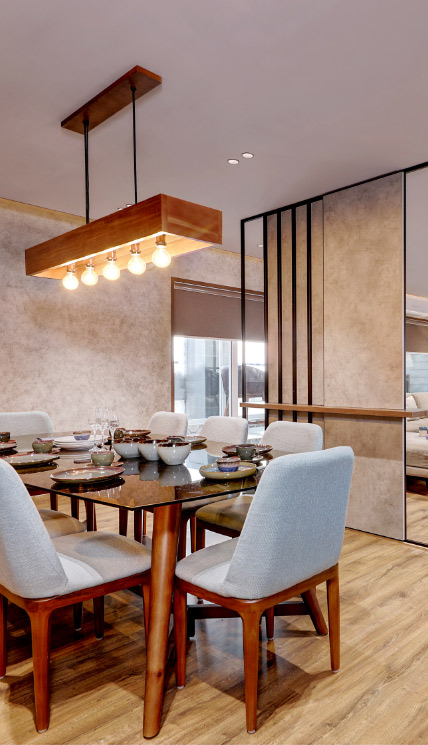Change Your Home With Essential Concepts of Interior Design and Appearances
By understanding the influence of color concept and the importance of appearance and patterns, one can develop spaces that are not just aesthetically appealing however also deeply individual. Achieving this balance entails even more than mere design; it encompasses a calculated setup and an eager understanding of how each component communicates within an area.
Recognizing Shade Theory
Color concept is a fundamental element of interior decoration that substantially affects mood, understanding, and general visual. Recognizing the concepts of color theory enables developers to produce areas that reverberate mentally with owners while meeting functional requirements (Architecture Firm). Colors can be classified right into three main types: primary, second, and tertiary. Each group plays an important function in establishing harmony within an area.
The mental influence of shades is extensive; warm colors such as reds and oranges stimulate energy and heat, while amazing tones like blues and environment-friendlies promote peace and harmony. The use of corresponding colors boosts visual passion, creating striking contrasts that can boost a room's charm.
Neutral colors, on the various other hand, act as a versatile background, allowing various other layout aspects to shine. It is crucial to consider factors such as lights and the area's function when picking a color scheme, as these can alter the understanding of colors throughout the day.
Ultimately, a well-considered color design can transform an area, cultivating a feeling of comfort and style that straightens with the residents' choices. Proficiency of color theory is, consequently, a crucial ability for any kind of interior developer aiming to create harmonious and welcoming atmospheres.
Attaining Balance in Design
Exactly how can developers accomplish a feeling of equilibrium in their spaces? Accomplishing balance in style is essential to producing unified interiors. Designers can utilize three key sorts of equilibrium: symmetrical, asymmetrical, and radial. Symmetrical equilibrium involves organizing aspects uniformly around a central point, promoting a feeling of order and tranquility. This kind typically features pairs of furnishings or art work, boosting aesthetic stability.
Unbalanced equilibrium, on the various other hand, counts on varying aspects that still accomplish a cohesive look. This technique enables for more vibrant and casual plans, offering interest while maintaining stability. By carefully picking differing dimensions, shades, and structures, designers can develop a visually engaging area that feels well balanced yet energetic.
Radial balance stresses a main focal factor with aspects radiating exterior. This style is typically seen in circular layouts, where furniture and design create a natural surround that attracts the eye inward.
Eventually, achieving equilibrium needs thoughtful consideration of range, proportion, and the relationships in between aspects. miami luxury interior design. By skillfully applying these equilibrium principles, designers can change spaces into settings that feel both visually pleasing and functionally harmonious, improving the overall experience for passengers
Importance of Spatial Understanding

A keen feeling of spatial recognition permits developers to recognize prime focus within an area, guiding the audience's attention to crucial functions while maintaining a general sense of unity. It also aids in the tactical placement of lights, which can substantially affect the assumption of room and state of mind. In addition, comprehending spatial connections allows the designer to cater to the specific demands of inhabitants, guaranteeing that each area offers its desired function without jeopardizing looks.
Inevitably, spatial understanding is important for optimizing the capacity of any kind of indoor space. By meticulously thinking about the interaction web between measurements, layout, and feature, designers can produce environments that not only meet practical needs but additionally evoke a sense of convenience and elegance, improving the overall living experience.
Integrating Appearance and Patterns
Embracing a varied variety of textures and patterns can dramatically enhance the aesthetic and responsive appeal of an indoor area. The strategic use different products-- such as wood, metal, textile, and stone-- creates depth and rate of interest, making an area feel much more welcoming and vibrant. Integrating smooth surface areas with harsh appearances can establish an equilibrium that attracts the eye and involves the detects.
When including patterns, take into consideration both scale and repeating. Big patterns can act as prime focus, while smaller sized, refined layouts can enhance various other elements without overwhelming the space. Layering patterns, such as pairing floral pillows with candy striped tosses, includes intricacy and a feeling of harmony if implemented attentively.
It is likewise important to maintain a natural shade scheme, making certain that structures and patterns collaborate instead than compete for attention. By picking a few key appearances and patterns, you can produce an unified visual that shows your individual design while improving the overall setting of the room. Ultimately, the cautious incorporation of these components can transform an ordinary room right into a sophisticated setting rich with character and heat.
Individualizing Your Area
Producing a room that reflects your character is essential to achieving a truly welcoming environment. Personalization in indoor layout enables you to instill your unique style and passions into your home, transforming it from a simple sanctuary into a shelter that talks with who you are. Begin by choosing a color scheme that reverberates with your emotions-- bold colors can invigorate, while soft tones provide serenity.
Include art work and decor that reflect your enthusiasms, whether it be traveling, nature, or abstract ideas. Presenting personal collections, such as publications, photographs, or souvenirs, can evoke valued memories and produce centerpieces within an area. In addition, consider customizing functional pieces, like upholstered furniture, to align with your aesthetic preferences.

Conclusion
Finally, the makeover of a home via the crucial principles of interior style and looks requires a comprehensive understanding of color concept, balance, spatial recognition, structure, and customization. Each aspect adds considerably to creating a harmonious and useful living atmosphere - miami interior design. By check my blog thoughtfully incorporating these my company concepts, people can enhance the visual allure and emotional resonance of their areas, ultimately promoting a home that mirrors distinct identities while giving comfort and functionality